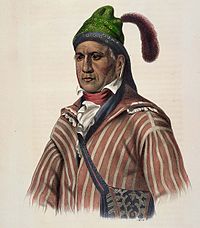Treaty of Indian Springs
This article needs additional citations for verification. (February 2011) |

There are two Treaties of Indian Springs with the Creek Indians. The first treaty was signed January 8, 1821. In it, the Lower Creek ceded land to the state of Georgia in return for cash payments totaling $200,000 over a period of 14 years. The state of Georgia was to receive payment from the Federal Government, to satisfy claims of citizens of Georgia against the Creek for seizure or destruction of property prior to the 1802 act of Congress that regulated relations with Indian tribes.
The leading signatory for the Lower Creek was the chief William McIntosh. The son of a Creek woman of the prominent Wind Clan and a Loyalist Scots officer, he supported the 'civilizing mission' of the U.S. Indian Agent Benjamin Hawkins. He led the Lower Creek Towns in the Creek War of 1813-14, against the traditionalist Red Stick faction of the Upper Creek, and the First Seminole War.
He acquired slaves and developed a medium-sized cotton plantation on the Chattahoochee at Lockhau Talofau (Acorn Bluff) in present-day Carroll County. For his role in signing the First Treaty of Indian Springs, McIntosh received 1,000 acres (4.0 km2) of land at Indian Springs. There he built a second plantation and a hotel to draw tourists to the local hot springs, then a popular destination.
The second treaty was signed at the Indian Springs Hotel on February 12, 1825 and ratified March 7, 1825. It was negotiated by McIntosh and his first cousin, Georgia Governor George Troup. Under this treaty the Lower Creek surrendered all of their lands east of the Chattahoochee, including the sacred Ocmulgee Old Fields, and accepted relocation west of the Mississippi River to an equivalent parcel of land along the Arkansas River. In compensation for the move to unimproved land, and to aid in obtaining supplies, the Creek nation would receive $200,000 paid in decreasing installments over a period of years. A controversial article provided additional payments to McIntosh for the lands granted to him in 1821.[1]
The treaty was popular with Georgians, who re-elected Troupe in the state's first popular election in 1825. It was signed by only six chiefs, and the Creek National Council denounced it, ordering the execution of McIntosh and the other Muscogee signatories, as it was a capital crime to alienate tribal land. On April 29, the Upper Creek chief Menawa took 200 warriors to attack McIntosh at his plantation at Lokchau Talofau. They killed him and another signatory, and set fire to the house.
The second Treaty of Indian Springs was ratified by the U.S. Congress by one vote, but a delegation from the Creek National Council, led by Chief Opothleyahola, traveled to Washington with a petition to John Quincy Adams to have it revoked. They negotiated the 1826 Treaty of Washington, in which the Muscogee surrendered most of the lands sought by Georgia under more generous terms, retaining a small piece of land on the Georgia-Alabama border and the Ocmulgee Old Fields. They were not required to move west.
Troup refused to recognize the new treaty, and ordered the Creek lands surveyed for a land lottery. He began forcibly evicting the Lower Creek. Adams threatened federal intervention, but backed down after Troup mobilized Georgia militia.
The area around the spring is protected as Indian Springs State Park between Jackson and Flovilla in Butts County, Georgia.
See also
References
- ^ "Treaty of Indian Springs, 1825", New Georgia Encyclopedia Online
